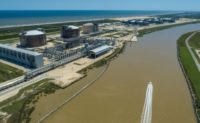Heavy rains have forced a busy Houston freeway ramp to close after a massive pavement split occurred. On Oct. 10, a 100-ft-long crack, measuring 7 to 10-in. wide, was discovered on a two-lane temporary ramp in the state's busiest intersection. The finding prompted the Texas Dept. of Transportation to shut down the 215-ft-long connector, while pursuing a four-week-long permanent fix.
 |
| Asphalt segment of ramp separated from conrete after heavy rains. |
The seven-month-old ramp, which saw 28,000 vehicles a day, connected southbound U.S. 59 to north Interstate 610 , two major thoroughfares that see a combined 550,000 cars each day. Designed by Binkley & Barfield Inc., Houston, the ramp was meant to alleviate traffic while construction occurred on a $32.7-million interchange addition. Williams Brothers Construction Co. Inc., Houston, has been working since Jan. 7 to build a network of frontage roads under U.S. 59 at Interstate 610.
An asphalt lane was added to the left side of the ramp in April to accomodate the loss of a lane on the right side, demolished for the final phase of construction, says Glenn Carlson, Binkley & Barfield's director of transportation.
The 40-mph ramp rests on an earthen embankment that had been shored with 35-ft-long corrugated metal retaining walls driven 18-ft into the ground. Workers had been excavating under the embankment to make way for the new frontage road.
After torrential rains, however, the asphalt roadbed on the left side of the ramp split off, sliding downhill. The permanent concrete right-hand lane stayed put, causing a fissure.
"The sheet piling on the inside area of the ramp failed," says Janelle H. Gbur, a TexDOT spokesperson. "Judging from the way the earth is moving, it appears the entire sheet is pulling away to the left."
The temporary roadway was intended to last until Nov. 28, when a permanent concrete fly-over could be completed. Lacking confidence that a quick repair could be done, TexDOT opted to move up its construction schedule by a month.
"In order to fix the problem it would take two weeks and it may not perform like we want it to," says Clifford W. Halvorsen, TexDOT's area engineer. "We can get the new bridge built in three to four weeks."
Soil saturation, retaining sheets that were too short and the contractor digging deeper than intended are responsible for the ramp's failure, he says.
TexDOT plans called for 6.5-ft-deep cuts for the new frontage road. They proved to be inadequate and were made 10 ft and then 15 ft by the contractor.
"Our plans were inadequate," Halverson says. "Had our original scope of work had been accurate, then our design would have been good. There is no reason not to do this again in the future . . . it was a combination of errors."
As such, no damages are being assessed against Williams Bros. The contractor is scheduled to have the new two-lane connector open by Nov. 6.




Post a comment to this article
Report Abusive Comment